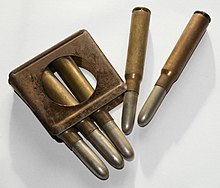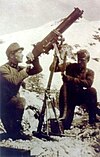Gewehr 1888
| Model 1888 commission rifle / Gewehr 88 | |
|---|---|
clip in a fixed external magazine |
The Gewehr 88 (commonly called the Model 1888 commission rifle) was a late 19th-century German
The invention of
Design
In 1886, fifteen years after their defeat by German forces in the
Cartridge

The first step was to select a new cartridge. This began by adapting a Swiss design, resulting in the Patrone 88 or M/88 of 1888, an 8 mm rimless "necked" cartridge (bullet diameter 8.08 mm/.318 in) loaded with an 8.08 mm (.318 in) 14.6 g (226 gr) round-nose bullet propelled by a single-base smokeless powder. In 1905, the 8 mm M/88 cartridge was replaced by the
Receiver and magazine

The Gewehr 1888 is a further development of the
Bolt and barrel
The commission rifle's bolt action design was a commission modified Mauser action. The barrel design and rifling were virtually copied from the French Lebel. The rifle has an odd appearance as the entire 'floating' barrel is encased in a sheet metal tube for protection, but with the tube removed the rifle looks rather modern. This tube was intended to increase accuracy by preventing the barrel from directly contacting the stock, but in practice it increased the risk of rusting by providing a space for water to be trapped if the rifle was exposed to harsh conditions. The Karabiner 88 utilized a different bolt handle, which resembled those found on commercial sporting rifles.
Service history
Some early models had flaws due to rushed ammunition production. This was used in 1892 by the then notorious
Part of the production run was exported to China (see lower) or Latin America (for example Brazil army use them in War of Canudos in 1896–1897). The commission rifle saw field service with Germany's colonial expansion, including in China during the Boxer Rebellion (with the Gewehr 88s and the unlicensed Hanyang 88 copies also being used by the opposing Chinese troops),[5] and served as a front line weapon for German troops during World War I until 1915 when the supply of Gewehr 98s increased. When Germany replaced the 88 with the Gewehr 98, many of the rifles were given to Austria-Hungary and the Ottoman Empire during World War I because both states had a shortage of rifles (however, it was used extensively by the Turkish Army even through the 1930s and 1940s). Many Gewehr 88 rifles stayed in active service in second-line units, reserves, and in armies allied with the Germans through and well past World War I.
Most of the Gewehr 88s seen in the US are the ones that were given to the Turkish forces in World War I and have been modified from the original design.[

China also used this rifle extensively during the
The rifle was adopted during a period of rapid development in
The Gewehr 88 was also sometimes made into very elegant sporting rifles by gunsmiths in Germany. Examples of these usually show first-class workmanship and special features such as folding sights and altered bolt handles. Some Karabiner 88 carbines are known to have been produced in 7×57mm Mauser instead of the usual M/88 or the 7.92×57mm Mauser chambering.[15] These were likely intended for sale in South America, where use of the 7×57mm cartridge was widespread. All known 7×57mm Karabiner 88s were produced by Haenel.
Variants

At the time of adoption, the M/88 "Patrone 7.9 mm" was loaded with a 14.6 g (226 gr) round nose bullet that measured 8.08 mm (.318 in) in diameter. In 1894/95 the
Modern ammunition use
The maximum operating pressure for the Gewehr 88 commission rifle is less than that of any 8 mm Mauser rifle, as the makers of the Gewehr 88 did not fully understand the greater energy of smokeless powder compared to black powder. Shooters planning to use modern 8 mm ammunition in a Gewehr 88 slug their bore and chamber as there are four different possible bores and grooves and chamber dimensioning combinations found on the Gewehr 88 rifle. High performance and hence high pressure or military ammunition designated for machine gun use cannot be fired safely in a Gewehr 88 commission rifle.
Defects
Although the packet loading system proved to be a design shortcoming, it is not uncommon to encounter a Gewehr 88 today which still retains it. Some of them were modified to use the stripper clips used with the Gewehr 98 by milling a slot into the left side of the action and adding stripper clip guides on the top of the receiver. Through this slot projects a bar which retains the cartridges in place against the magazine spring's pressure. The hole in the bottom of the rifle is often covered with a small piece of sheet metal.
Unlike many rifles designed later, the bolt head of this rifle is able to be removed from the bolt body. This piece could be removed during disassembly, and was frequently lost. Additionally, both the ejector and the extractor that are attached to the bolt head are prone to falling out if care is not taken during disassembly and reassembly.
Users
 Austria-Hungary[16]
Austria-Hungary[16] Brazil[17][18]
Brazil[17][18] Kingdom of Bulgaria[19]
Kingdom of Bulgaria[19] Czechoslovakia
Czechoslovakia Ecuador[20]
Ecuador[20] Ethiopian Empire: obtained after 1896 from German and Belgian arms dealers[21][22]
Ethiopian Empire: obtained after 1896 from German and Belgian arms dealers[21][22] France: captured carbines were issued to second-line soldiers, such as car drivers[23]
France: captured carbines were issued to second-line soldiers, such as car drivers[23] German Empire[24]
German Empire[24] Nazi Germany: Used by Volkssturm[25]
Nazi Germany: Used by Volkssturm[25] Kingdom of Greece[26]
Kingdom of Greece[26] Haganah[27]
Haganah[27] Irish Republic[12][28]
Irish Republic[12][28] Malayan National Liberation Army: Karabiner 88 variant, supplied by Soviet Union only in small numbers[29]
Malayan National Liberation Army: Karabiner 88 variant, supplied by Soviet Union only in small numbers[29] Orange Free State[30]
Orange Free State[30] Ottoman Empire[31]
Ottoman Empire[31] Peru[32]
Peru[32] Second Polish Republic[10][33]
Second Polish Republic[10][33] Qing dynasty[34]
Qing dynasty[34]- anti-Japanese guerillas used the Hanyang 88, a copy of the Gewehr 1888[35]
 South African Republic[30]
South African Republic[30] Republic of Lithuania About 5,500 rifles and carbines from 1919–1940
Republic of Lithuania About 5,500 rifles and carbines from 1919–1940 Spanish Republic: Acquired approximately 2,000 through Poland during the Spanish Civil War[36]
Spanish Republic: Acquired approximately 2,000 through Poland during the Spanish Civil War[36] Turkey: received during World War I,[37] leftover Ottoman stock used in Turkish War of Independence
Turkey: received during World War I,[37] leftover Ottoman stock used in Turkish War of Independence Kingdom of Yugoslavia
Kingdom of Yugoslavia United Kingdom: Used by Home Guard
United Kingdom: Used by Home Guard- Ulster Volunteers[38]
Conflicts
- First Sino-Japanese War[39]
- Revolta da Armada
- Federalist revolution[40]
- War of Canudos[41]
- Second Boer War
- Boxer Rebellion
- Herero Wars
- Maji Maji Rebellion[42]
- Mexican Revolution[43]
- Mexican Border War[43]
- Chinese expedition to Tibet (1910)[34]
- Xinhai Revolution
- World War I
- Easter Rising
- Warlord Era
- Russian Civil War[44]
- German Revolution of 1918–19
- Revolutions and interventions in Hungary (1918–20)
- Greater Poland Uprising (1918–19)
- Polish–Soviet War
- Irish War of Independence
- Silesian Uprisings
- Turkish War of Independence[45]
- Lithuanian Wars of Independence
- Sheikh Said rebellion
- Ararat rebellion
- Constitutionalist Revolution
- Chinese Civil War
- Second Italo-Ethiopian War[46]
- Spanish Civil War[47]
- Dersim rebellion
- Second Sino-Japanese War[39]
- Sudeten German uprising 1938
- World War II
- 1948 Palestine war[48]
- Malayan Emergency[49]
- Korean War[50]
Gallery
-
Cutaway model of the Gewehr 88
-
Schematic. Images #5 and #6
-
Cartridges M88
See also
References
- ^ John from Texas (Webmaster). "German M.1888 7MM Commission Carbine". collectiblefirearms.com. Archived from the original on 2011-07-16. Retrieved 2009-10-23.
- ^ a b 8×57mm IS cartridge portrait – Totgesagte leben länger, Wild und Hund 11/2006 (in German) Archived 2011-10-01 at the Wayback Machine
- ^ a b Hardin, John. "The Model 1888 Commission Rifle". Archived from the original on 2008-10-30. Retrieved 2009-10-19.
- ^ Detje, Robin (8 January 2004). "ZEIT ONLINE | Lesen Sie zeit.de mit Werbung oder im PUR-Abo. Sie haben die Wahl". Die Zeit.
- ^ Ball 2011, p. 150.
- ^ "Rifles of Yugoslavia and Serbia".
- ^ "VHU PRAHA".
- ^ "Broń strzelecka polskiego wojska w wojnie polsko-bolszewickiej".
- ^ "El Fusil Aleman Modelo 1888" (PDF). Archived from the original (PDF) on 2016-03-04. Retrieved 2015-09-04.
- ^ a b "Karabin i karabinek Mannlicher-Mauser wz.1888". dobroni.pl. Archived from the original on 2016-03-05. Retrieved 2015-09-18.
- ^ "Fremden Gerät".
- ^ a b "Firearms of the Irish Civil Wars: Part 2 the Republicans: their Unionist opponents had a much better quantity and variety of arms, but the Republicans put theirs to a lot more use".
- ISBN 978-3-8370-4042-5.
- ^ "1888 Commissioned Rifle Project".
- ^ John from Texas (Webmaster). "German M.1888 7MM Commission Carbine". collectiblefirearms.com. Archived from the original on 2011-07-16. Retrieved 2009-10-23.
- ^ "M1913 Mannlicher Gew88 Austro Hungarian Rifle".
- ^ "brazilpage".
- ^ "Brazilian military rifle cartridges part 2: Steyr vs. Mauser and fn wins! - Free Online Library".
- ISBN 978-1-4402-1451-6.
- ^ Ball 2011, p. 127.
- ^ Scarlata, Paul (Mar 1, 2009). "Ethiopian military rifle cartridges: Part 2: from Mauser to Kalashnikov". Shotgun News.
- ^ "Rifles of Emperor Menelik II: Ethiopian Gewehr 88 and Karabiner 88". 5 February 2020.
- ^ Boniface, Jean-Michel; Vauvillier, François (July 1987). "L'armement des automobilistes, 1914-1918" [The weapons of the motorists, 1914-1918]. Armes Militaria Magazine. No. 22–23. p. 73.
- ^ "Germany". oldrifles.com. Archived from the original on 1999-03-02.
- ISBN 978-3-7431-5333-2.
- ^ "Weapons Of The Greco-Turkish War Part 1". Archived from the original on 2015-10-05. Retrieved 2015-09-18.
- ^ "Israeli Small Arms IDF issue weapons [Archive] - UZI Talk Forums".
- ^ "Le G88 Kommission Gewehr". tircollection.com.
- ^ "Weapons of the Malay CTs 1948–1960". 17thdivision.tripod.com.
- ^ a b R. Bester, Boer Rifles and Carbines of the Anglo-Boer War, War Museum of the Boer Republics, Bloemfontein, 1994 (See also Wessels 2000, p. 80).
- ^ Garander. "Turk Mauser – Gew. 88".
- ^ "Issues | RifleMagazine" (PDF).
- ^ "Zbrojownia tamtych lat – Arsenał odrodzonej armii".
- ^ ISBN 9781472814272.
- ISBN 9781855326651.
- ISBN 978-0312241773.
- ^ Garander (2013). "Gew. 88". turkmauser.com.
- ^ "Weapons of the Irish Revolution – part I 1914–16". The Irish Story.
- ^ Shotgun News.
- ^ "ArmasBrasil - Carabina Mannlicher". www.armasbrasil.com. Retrieved 2022-09-05.
- ^ "Fuzil da Comissão Alemã de 1888 "Gewehr '88" (Rev. 1b)". Armas On-Line. 5 August 2009.
- ^ http://www.wildlife-baldus.com/download/Maji_Maji.pdf [bare URL PDF]
- ^ a b "The "Bandit War" and the Porvenir Massacre" (PDF).
- ^ "Russian rifles of the great war, revolution & civil war--part I". Retrieved 2015-09-04.
- ^ "Weapons Of The Greco-Turkish War Part 2".
- ^ "Three members of the Ethiopian Zabagna, or gendarmerie, photographed about the time of the Italian invasion in the fall of 1935 [721 x 807] : HistoryPorn". reddit. 25 November 2013.
- ^ "República – Armas – Infantería – Fusiles".
- ^ "The rifles of Israel 1948-1980 - Israel Military Forum". Archived from the original on 2017-10-17. Retrieved 2017-06-01.
- ^ "Weapons of the Malay CTs 1948–1960". 17thdivision.tripod.com.
- ^ "The Official NJGF Photo Thread!". New Jersey Gun Forums. 11 April 2009.
- Ball, Robert W. D. (2011). Mauser Military Rifles of the World. Iola: Gun Digest Books. ISBN 9781440228926.
- Wessels, André (2000). "Afrikaners at War". In Gooch, John (ed.). The Boer War: Direction, Experience and Image. London: Cass.




